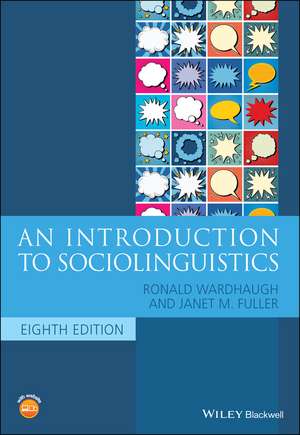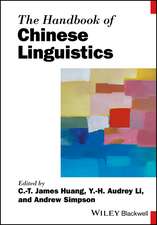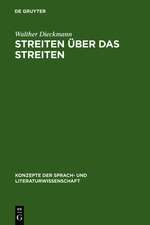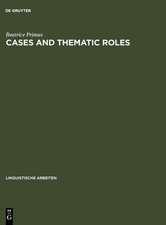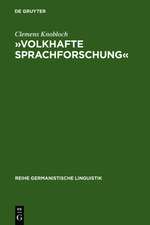An Introduction to Sociolinguistics: Blackwell Textbooks in Linguistics
Autor R Wardhaughen Limba Engleză Paperback – 21 apr 2021
Din seria Blackwell Textbooks in Linguistics
-
 Preț: 317.39 lei
Preț: 317.39 lei -
 Preț: 318.63 lei
Preț: 318.63 lei -
 Preț: 309.58 lei
Preț: 309.58 lei -
 Preț: 238.83 lei
Preț: 238.83 lei -
 Preț: 319.78 lei
Preț: 319.78 lei -
 Preț: 367.31 lei
Preț: 367.31 lei -
 Preț: 442.30 lei
Preț: 442.30 lei -
 Preț: 331.67 lei
Preț: 331.67 lei - 23%
 Preț: 461.71 lei
Preț: 461.71 lei - 23%
 Preț: 577.66 lei
Preț: 577.66 lei -
 Preț: 368.24 lei
Preț: 368.24 lei - 23%
 Preț: 557.93 lei
Preț: 557.93 lei - 23%
 Preț: 435.69 lei
Preț: 435.69 lei - 23%
 Preț: 524.72 lei
Preț: 524.72 lei - 27%
 Preț: 945.54 lei
Preț: 945.54 lei -
 Preț: 480.78 lei
Preț: 480.78 lei -
 Preț: 548.93 lei
Preț: 548.93 lei -
 Preț: 418.28 lei
Preț: 418.28 lei -
 Preț: 538.92 lei
Preț: 538.92 lei - 23%
 Preț: 451.87 lei
Preț: 451.87 lei - 23%
 Preț: 421.98 lei
Preț: 421.98 lei - 33%
 Preț: 652.04 lei
Preț: 652.04 lei
Preț: 347.38 lei
Nou
Puncte Express: 521
Preț estimativ în valută:
66.48€ • 72.19$ • 55.84£
66.48€ • 72.19$ • 55.84£
Carte disponibilă
Livrare economică 01-15 aprilie
Livrare express 18-22 martie pentru 55.08 lei
Preluare comenzi: 021 569.72.76
Specificații
ISBN-13: 9781119473428
ISBN-10: 111947342X
Pagini: 480
Dimensiuni: 170 x 244 x 26 mm
Greutate: 0.91 kg
Ediția:8th Edition
Editura: Wiley
Seria Blackwell Textbooks in Linguistics
Locul publicării:Chichester, United Kingdom
ISBN-10: 111947342X
Pagini: 480
Dimensiuni: 170 x 244 x 26 mm
Greutate: 0.91 kg
Ediția:8th Edition
Editura: Wiley
Seria Blackwell Textbooks in Linguistics
Locul publicării:Chichester, United Kingdom
Notă biografică
RONALD WARDHAUGH is Professor Emeritus in the Department of Linguistics at the University of Toronto, Canada. He is the author of number of books, including Proper English (Wiley Blackwell, 1998) and Understanding English Grammar, Second Edition (Wiley Blackwell, 2003). JANET M. FULLER is Professor and Chair of Language and Society, Department of European Languages and Cultures, University of Groningen, The Netherlands. Her previous publications have explored many aspects of multilingualism, with a recent focus on language ideologies, social identities, and discourses of national belonging. She is the author of Spanish Speakers in the USA and Bilingual Pre-Teens: Competing Ideologies and Multiple Identities in the US and Germany, and co-author of Speaking Spanish in the US and co-editor of Studies in Contact Linguistics.
Cuprins
List of Figures xiii
List of Tables xiv
Acknowledgments xv
About the Companion Website xvii
1 Introduction 1
Key Topics 1
The Nature of Language 2
Knowledge of Language 3
Competence and performance 4
Variation 6
Variants and the linguistic variable 7
Language Users and Their Groups: Identities 8
Language and Culture 10
Directions of influence 11
The Whorfian hypothesis 11
Correlations 13
The Interdisciplinary Legacy of Sociolinguistics 14
Overview of the Book 16
Chapter Summary 16
Exercises 17
Further Reading 18
References 19
Part I Languages, Communities, and Contexts 23
2 Languages, Dialects, and Varieties 25
Key Topics 25
What is a Language? 25
Language or Dialect? 26
Mutual intelligibility 27
The role of social identity 29
Standardization 30
The standard as an abstraction 30
The standardization process 31
The standard and language change 32
Standard language? 33
The standard-dialect hierarchy 33
Regional Dialects 34
Dialect geography 34
Everyone has an accent 35
Social Dialects 36
Kiezdeutsch 'neighborhood German' 37
Ethnic dialects 39
African American Vernacular English 40
Features of AAVE 41
Development of AAVE 42
Societal aspects of AAVE Use 43
Styles and Indexes: The Social Meanings of Linguistic Forms 43
Chapter Summary 47
Exercises 47
Further Reading 48
References 49
3 Defining Groups 55
Key Topics 55
Speech Communities 56
Linguistic boundaries 56
Shared norms 57
Communities of Practice 60
Social Networks 62
Social Identities 64
Beliefs about Language and Social Groups 65
Language ideologies 66
The standard language ideology 66
The purist ideology 67
Monoglossic ideologies 67
Iconicity, erasure, and recursivity 68
Language attitudes 69
Perceptual dialectology 69
Matched/verbal guises 70
Implicit association task (IAT) 71
Chapter Summary 72
Exercises 72
Further Reading 73
References 74
4 Language in Context: Pragmatics 79
Key Topics 79
Speech Acts 79
Performatives 80
Implicature 83
Maxims 83
Politeness 85
Face 85
Positive and negative politeness 86
Beyond politeness theory 87
Politeness and indirectness 88
Pronouns 89
Tu and vous: power and solidarity 89
Pronouns and positioning 92
Naming and Titles 92
Fluidity and change in address terms 94
Chapter Summary 97
Exercises 97
Further Reading 100
References 100
Part II Theory and Methods 105
5 Language Variation and Change 107
Key Topics 107
Variables and Correlations 107
Types of linguistic variables 108
Indicators, markers and stereotypes 109
Independent variables 109
Data Collection and Analysis 110
The observer's paradox 110
The sociolinguistic interview 110
Sampling 111
Apparent time and real time 112
Doing Quantitative Research: What Do the Numbers Really Mean? 112
Regional Variation 113
Mapping dialects 114
Methods in dialectology 115
Dialect mixture and free variation 117
Linguistic atlases 117
Social Variation 118
Social class membership 118
The First Wave of Variation Studies 120
Early work on gender variation 121
The fourth floor 121
Variation in Norwich 124
Variation in Detroit 124
Variation in Glasgow 125
Linguistic constraints on variation 126
Language Variation and Change 127
Change from above and below 127
Some changes in progress 127
Change across space: urban centers and physical barriers 129
Change over time or age-grading? 129
Martha's Vineyard 131
Gender and language change 132
Language change and the linguistic marketplace 136
The Second Wave of Variation Studies 137
Social networks 138
Social network theory and language change 139
Gender variation in the second wave 140
Jocks and burnouts 141
The Third Wave of Variation Studies 142
Stance, style, and identity 142
Change across the lifespan 144
Chapter Summary 144
Exercises 144
Further Reading 146
References 146
6 Ethnographic Approaches in Sociolinguistics 153
Key Topics 153
Ethnography: Participant Observation 153
The Ethnography of Communication 155
Communicative competence 156
The communicative event and communicative acts 157
The SPEAKING device 157
Ethnography and beyond 160
Ethnomethodology 161
Background knowledge as part of communication 161
Commonsense knowledge and practical reasoning 162
Garfinkel and his students: studies in ethnomethodology 163
Ethnomethodology and conversation analysis 164
Critical Ethnography 164
(Socio)linguistic Ethnography 165
Digital Ethnographies: Research in Online Communities 167
Ethnography in Combination with Other Sociolinguistic Methods 168
Chapter Summary 169
Exercises 169
Further Reading 171
References 172
7 Discourse Analysis 175
Key Topics 175
Conversation Analysis 176
Adjacency pairs 177
Openings 178
Closings 179
Turn-taking 181
Repair 182
Institutional talk 183
Membership categorization 185
Interactional Sociolinguistics 185
Data and methodologies 186
Contextualization and stance 188
Identities 189
Critical Discourse Analysis 192
Contrasts and critiques 193
Methodologies and connections 193
Corpus Linguistics 196
Chapter Summary 198
Exercises 198
Further Reading 199
References 200
Part III Multilingual Matters 207
8 Languages in Contact: Multilingual Societies and Multilingual Discourse 209
Key Topics 209
Multilingualism as a Societal Phenomenon 210
Language competencies in multilingual societies 211
Language ideologies surrounding multilingualism 211
Linguistic landscapes 213
Language attitudes in multilingual settings 216
Language Maintenance and Shift 218
Diglossia 219
Domains 220
Language attitudes and ideologies 220
Language learning 220
The statuses of the H and L varieties 221
Extended diglossia and language maintenance 222
Questioning diglossia 223
Multilingual Discourse 224
Metaphorical and situational codeswitching 225
Communication accommodation theory 225
The markedness model 226
Multilingual identities 227
Bricolage 230
Chapter Summary 231
Exercises 231
Further Reading 235
References 235
9 Contact Varieties: Structural Consequences of Social Factors 243
Key Topics 243
The Structure of Codeswitching 243
Loanwords and Calques 245
Convergence 246
Ethnicized and Social Dialects as Contact Varieties 247
Latinx Englishes 248
Straattaal 'street language' 249
Mixed Languages 250
Lingua Francas 252
Pidgin and Creole Languages: Definitions 253
Connections between P/C languages and second language acquisition 254
Creole Formation 255
Theories of creole genesis 256
Geographical Distribution 258
Linguistic Characteristics of P/C Languages 259
Phonology 260
Morphosyntax 260
Vocabulary 261
From Pidgin to Creole and Beyond 262
Creole continuum? 263
Chapter Summary 265
Exercises 265
Further Reading 266
References 266
10 Language, the Nation, and Beyond 273
Key Topics 273
Language and Nation 273
Nationalism and language 274
Language and national identity categories 278
Belonging beyond the nation 280
Language and Migration 282
Identity construction in the context of migration 282
Identity over time and space 284
Diversity and superdiversity 287
Discourses of migration and integration 288
LADO 291
Language and Globalization 293
Global English: threat or promise? 295
Language and the Digital World 296
Chapter Summary 298
Exercises 298
Further Reading 298
References 299
Part IV Sociolinguistics and Social Justice 305
11 Language, Gender, and Sexuality 307
Key Topics 307
Defining Terms: Sex Category, Gender, and Sexuality 307
Sexist Language 309
Grammatical gender marking 310
Language change 312
Deficit, Dominance, and Difference 313
Women's language as a deficit 314
Dominance 315
Difference 316
Gender and Sexuality Identities 317
Multiple identities 318
The role of hegemonic ideologies in gender and sexuality identity construction 319
Context-specific identity construction: the workplace 321
Discourses of Gender and Sexuality 323
Normative discourses 323
Discourses about language use 325
Chapter Summary 326
Exercises 326
Further Reading 327
References 327
12 Sociolinguistics and Education 335
Key Topics 335
Social Dialects and Education 336
Restricted codes and the language gap 336
Difference not deficit 337
Role of the home dialect in education 340
An achievement gap? 342
Education in Multilingual Contexts 343
Ideologies 343
Use of minoritized languages in the classroom 345
Elite and immigrant bilingualism 348
Education and World-Wide English 349
Circles of English 350
English in world-wide education 350
Elite closure 351
English in Europe 353
Chapter Summary 354
Exercises 355
Further Reading 356
References 356
13 Language Policy and Planning 365
Key Topics 365
Terminology, Concepts, and Development of the Field 365
Types of language planning 366
The intellectual history of LPP 369
Data and methods 370
LPP and Nationalization 372
LPP in Turkey: orthography and purity 372
LPP in the Soviet Union and the post-Soviet era: from Russification to nationalization 373
Official monolingualism in France 375
LPP in Post- and Neo-Colonial Contexts 376
Kenya 376
India 377
Multilingual Countries and LPP 378
Canada 379
Belgium 380
Papua New Guinea 381
Singapore 381
Feminist Language Planning 382
Endangered Languages and the Spread of English 384
Endangered languages 384
Family language policy, new speakers, and LPP 385
English world-wide 387
Language policy ... or lack thereof 389
Chapter Summary 389
Exercises 389
Further Reading 390
References 391
Glossary 397
Index 421
